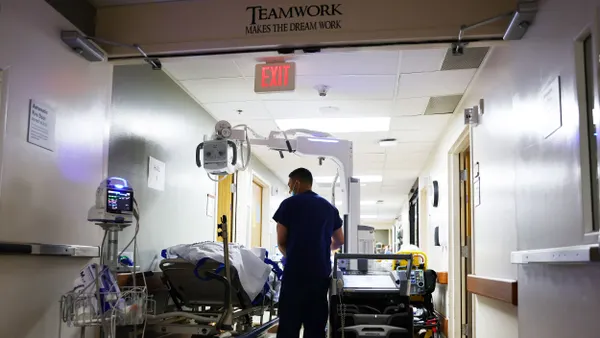Dive Brief:
-
Diagnostic errors topped ECRI Institute’s 2018 Top 10 Patient Safety Concerns for Healthcare Organizations.
-
The errors, which ECRI Patient Safety Analyst Gail M. Horvath said are common and have “serious consequences,” can cause gaps, repeat testing, unnecessary procedures and patient harm.
-
Rounding out the report's top five concerns were: opioid safety across the continuum of care, internal care coordination, workarounds and incorporating health IT into patient safety programs.
Dive Insight:
William Marella, executive director of operations and analytics of patient safety, risk and quality at ECRI Institute, said the top 10 isn’t a list of the most frequent or severe issues. “Rather, this list identifies concerns that have appeared in our members' inquiries, their root cause analyses and in the adverse events they submit to our patient safety organization," Marella said.
Patient safety can play a major role at a hospital. It touches upon patients’ outcomes, as well as a facility’s quality, public relations and increasingly hospitals’ bottom lines as more payers look to pay for value rather than volume.
Horvath said miscommunication is a common problem for diagnostic errors, which topped the list, but many factors go into the problem. “Diagnostic errors are also challenging to measure and learn from because they often go undetected until after the patient leaves the hospital or emergency department,” the report said.
The report said one way to “overcome cognitive biases that lead to errors” is using structured tools and algorithms. Organizations can “capture data using a variety of methods and then develop non-punitive ways of learning from errors when.”
ECRI Institute recommended that organizations capture data on diagnostic errors and near misses. Data could include the event-reporting system, malpractice and payment claims and patient surveys.
“The organization can then make changes to address gaps. Discussing the topic in multiple forums, such as grand rounds and debriefings, can support ongoing analysis and learning for clinicians,” according to the report.
Opioid safety, which ranked second on the list, is a patient safety issue, but the issues go well beyond that. ECRI Institute recommended that clinicians “carefully assess patients for opioid use disorder and set realistic expectations about pain,” Stephanie Uses, patient safety analyst and consultant at ECRI Institute, said.
Regarding the fifth item on the list, “incorporating health IT into patient safety programs,” the report said IT safety programs can improve quality, but a key is for users to report health IT-related events for analysis and action. If staff members don't recognize health IT issues, they might not know how to intervene, ECRI Institute said.
Poorly designed or implemented health IT safety programs also cause patient safety issues.
Further down the list was “patient engagement and health literacy.” With inpatient care not as common, patients are increasingly managing their health at home. This puts more emphasis on patients and caretakers to improve health literacy and understand how to care for themselves and their loved ones. However, most Americans don’t understand basic healthcare terms and a campaign to improve clinical conversations to educate patients about avoiding low-value care, hasn’t resonated.
Josi Wergin, risk management analyst at ECRI Institute, said healthcare doesn’t properly engage patients or make sure they understand their health and healthcare. Not doing so can lead to patient harm.
The report suggested healthcare organizations involve patients and families on health literacy and patient engagement. ECRI Institute recommended working with patients on health goals and helping them achieve those goals.
The report also suggested healthcare organizations work with government and community groups to tackle social determinants of health. These factors, which can include homelessness and not having regular access to food or transportation, can cause barriers to better health. Providers are increasingly going beyond population health and factoring in social determinants when caring for patients.













